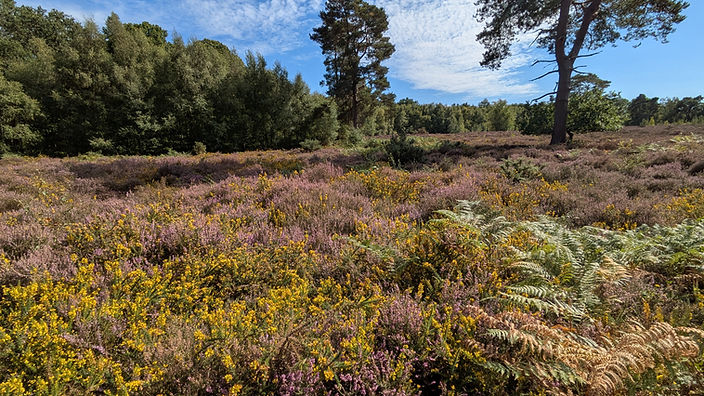
News Summer 2025
Fire on Blackeath!
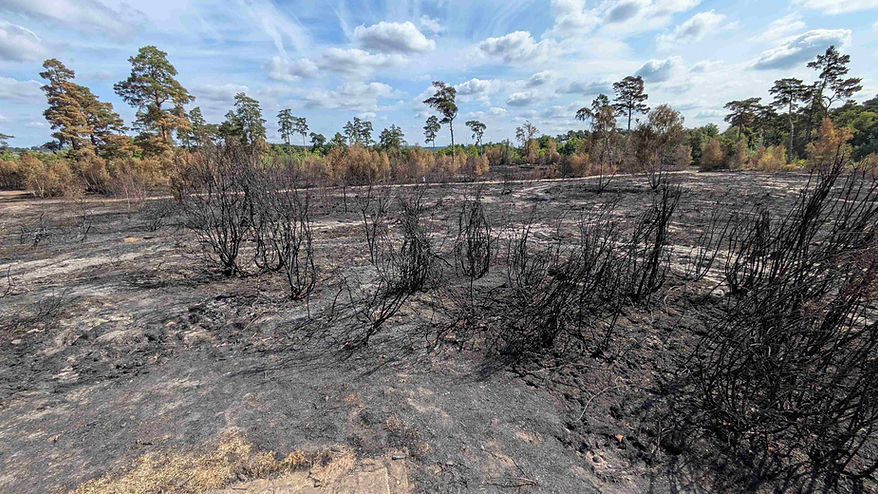
In stark contrast to the colourful heather and dwarf gorse clothing the rest of the heath, the area around the War Memorial is a sorry sight at the moment. On Friday 15th August the fire brigade managed to put out a blaze started by an out of control campfire, but 5 hectares of heath are now reduced to what appears to be bare sand with a few blackened twigs here and there, and some badly scorched pine trees.
We will be keeping a close eye on the area to see how it regenerates. Heather responds to a controlled burn by producing new shoots from the base, but controlled burning would be done when the soil is cool and damp and would be extinguished before the roots are damaged. Our fire was very different and the roots will certainly have suffered, so regeneration will rely more on the seed bank in the soil - if burning doesn't kill heather seeds it can actually stimulate them to sprout.
It's unfortunate that this area was the only place on Blackheath where you could find Cross-Leaved Heath (Erica tetralix). This is a relative of the more common magenta-coloured bell heather (Erica cinerea) but it is only found in boggy areas and there was a nice little colony of it in a wet depression to the East of the War Memorial. No sign of it now, but it may return...
The fire service remained on site for a week, with off-road fire trucks regularly patrolling and dealing with hot spots. It was a very worrying time for local residents, especially on the day of the fire when a light northerly breeze was sending the fire towards them and it got to about 150m from the old Villagers pub.

Off-road fire vehicles kept the perimeter damped down

Cross-leaved heath lived here - will it return?
Watering the New Hedge
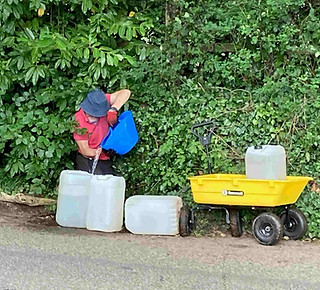
Filling up from the stream
We are having to take lots of measures to try and keep our 1000 new hedge saplings going in this year's exceptionally hot, dry weather - we have learnt the hard way that climate change is real and happening now !! A leaky hose has been installed, thanks to Sean at Woodhill Manor, and also a sun screen by Regena and our volunteers.
Our initial efforts at watering by collecting water from the nearby stream and also Hascombe spring were back breaking but critical until the hose was installed. A lot of wood chip has now been applied as mulch around the plants, thanks again to Sean.

Leaky hose now delivers water regularly to the saplings
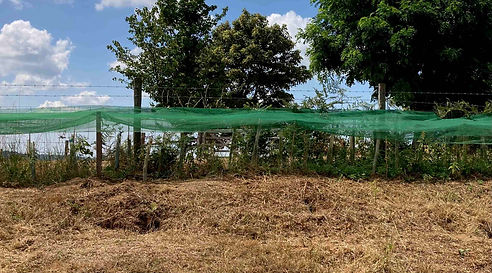
Sun protection for the saplings
Management of the Shamley Green Duck pond

A welcome influx of water on 21st July after a weekend of heavy rain
Snails, shrimps and caddis-fly larvae are known to survive for quite long periods in damp mud, and we have found froglets sheltering in damp cracks in our apparently dry pond base. There is also a wide range of invertebrates particularly associated with ponds that dry out from time to time, including damselflies such as the Scarce Emerald and Scarce Blue-tailed Damselflies, together with snails such as the Button Ram’s-horn, and many beetles and caddis-flies. Almost all marginal plants start their life in periodically drying areas because their seeds need exposure to air before they will germinate.
Click here for lots more information about ponds drying out.
Changes in weather patterns mean we are seeing increasingly frequent extended droughts and, as in 2022, the Duck pond has dried out again this summer after an exceptionally dry spring. There was less than 3 inches of rain during the three months between the beginning of April and the end of June.
See our latest report for more details.
The pond drying out does look worrying, but for the plants and animals living there it's not a disaster, in fact about half of all freshwater plant and animal species are tolerant of periods of drought and some even benefit from it. This is because in the ancient past many ponds will have been created by natural processes such as tree-fall pools or meander cut-offs. These ponds will always have been shallow and susceptible to drying out in drought years, so their plant and animal populations have evolved coping strategies.
Some Shamley Green residents have suggested ways to stop this happening, but any intervention needs to be very carefully thought about and for the resident wildlife it could actually do more harm than good. That said, the pond is a village amenity so efforts have been made to improve the water flow into the pond by clearing ditches in the winter, installation of a silt trap and encouraging run off from private land as the latest report on water flows shows. Wonersh Parish Council manages the Duck Pond and has produced this helpful FAQ answering residents' questions about it.
Shamley Green Fete June 12th 2025
We had a stall at the SG fete. It was hot and as usual very windy - most of our displays had to be held flat with old socks stuffed with stones! however this did not stop people visiting and in particular handling some toads and frogs.
We might not have had as many visitors as the ice cream stall but there was good interest in the toads and swifts and we signed up some potential new friends
We now have around 165 friends on our mailing list from 137 households. If you know anyone who would like to be on our mailing list please do tell them to contact us.
Hopefully around 10 new swift boxes will go up over the autumn courtesy of Sarah Davis from the Guildford Swift project - Sadly no reports of swifts nesting here in the village so far despite our 61 boxes but we are hopeful that our time will come.


Carefully handling a toad
Birdwatching on Blackheath
Armed with binoculars and the Cornell 'Merlin' bird call app, the SG bird group spent a balmy June evening on Blackheath.
First up, Stonechats – easy to find sitting on top of bushes drawing attention to themselves with their sharp, clicking call and distinctive black, brown and white plumage.
Dartford Warblers are more tuneful but harder to see, though we eventually did, skulking in the gorse. They are rare and on the red list. It was good to hear them on several parts of the Heath.
A pair of Dartford warblers in gorse
As dusk came on the nightjars started churring and we were lucky to see several flying with their distinctive long, pointed wings and slow wing flap. They are rare, ground nesting summer visitors to our heathland, known in earlier times as ‘goatsuckers’.
And also nice to see some woodcock flying. These are traditionally game birds but also now on the red list of endangered species.

Woodcock in flight
Duck Pond in June
Our young wildfowl went exploring in early June, once they were old enough to wander about. The geese were particularly adventurous and wandered around the lanes oblivious to the vehicles. Big efforts were made by neighbours on Woodhill Lane to slow the traffic and keep them safe. Eventually the goslings relocated to another much quieter pond. Strangely they adopted new parents, the geese who were already resident there, or maybe it is not strange, just pragmatic!
By 11th June there was only one duckling left on rather a shallow pond. Hopefully the others had found refuge elsewhere, or as Claire Jenkinson suggested 'There are a lot of moorhens and they can be rather aggressive - maybe they are responsible for the recent demise of the ducklings'.
However there had also been recent sightings of a fox, a heron in the pond and a red kite, and that’s to add to the potential risks from mink, rats, cats and other male ducks - who would want to be a duckling!

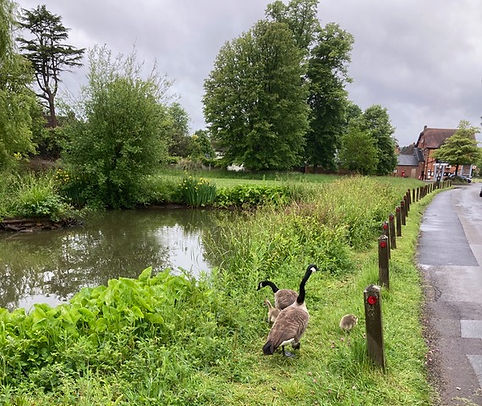
Geese by the road
Heathland Connections
Shamley Green falls inside the 5km boundary buffer zone of a new Heathland Connections project being managed by Surrey Wildlife Trust (SWT). The project is looking to restore and create as many different types of habitats in the area as possible - not just heathland.
Its aim is to work with a range of landowners and managers and the 53 parish councils 'to enhance or create additional habitat to help support wider ecology and explore opportunities locally in the landscape for connectivity’. Many local landowners and our parish council have already signed up to this project but so many others could take part and benefit from SWT’s expertise.
For lots more information about this great project click here
As a result of our early involvement with the project SWT have kindly provided Wonersh Parish with very interesting habitat maps and also a report on how to manage our various habitats, a summary of which can be found here, and if you are interested in managing land for horses see equiculture top tips




